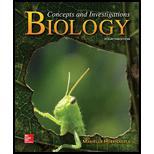
Introduction:
The aquatic biome is the largest biome present in the Earth. This biome is divided into two regions: freshwater biome (rivers and ponds) and marine biome (estuaries and oceans).
Answer to Problem 1MCQ
Correct answer:
“The major primary producer in aquatic biome is phytoplankton”. Therefore, option c. is correct.
Explanation of Solution
Reason for the correct statement:
The primary producers are autotrophic organisms, as they use sunlight to make their own organic molecules. The phytoplankton is microscopic, free floating aquatic organisms and they use solar energy to synthesize their own food particles. Thus, the phytoplanktons are the primary producers in aquatic biomes.
Option c. is given as “phytoplankton”.
As “the phytoplankton is the primary producers in aquatic biomes” is the right answer.
Hence, option c. is correct.
Reasons for the incorrect statements:
Option a. is given as “Underwater plants”.
The underwater plants are not the primary producers because the phytoplanktons are present in large amount which create hindrance for penetrating the light in deep water. Thus, the plants does not get enough amount of sunlight for photosynthesis So, it is a wrong answer.
Option b. is given as “The sun”.
Sun does not act as a producer. So, it is a wrong answer.
Option d. is given as “Insect larvae”.
Insect larvae are not autotrophs. They did not synthesise their own food. So, it is a wrong answer.
Hence, options a., b. and d. are incorrect.
Phytoplanktons is the primary producers in aquatic biomes.
Want to see more full solutions like this?
Chapter 39 Solutions
Biology: Concepts and Investigations
- Molecular Biology Explain/discuss how “slow stop” and “quick/fast stop” mutants wereused to identify different protein involved in DNA replication in E. coli.arrow_forwardMolecular Biology Question A gene that codes for a protein was removed from a eukaryotic cell and inserted into a prokaryotic cell. Although the gene was successfully transcribed and translated, it produced a different protein than it produced in the eukaryotic cell. What is the most likely explanation?arrow_forwardMolecular Biology LIST three characteristics of origins of replicationarrow_forward
- Molecular Biology Question Please help. Thank you For E coli DNA polymerase III, give the structure and function of the b-clamp sub-complex. Describe how the structure of this sub-complex is important for it’s function.arrow_forwardMolecular Biology LIST three characteristics of DNA Polymerasesarrow_forwardMolecular Biology RNA polymerase core enzyme structure contains what subunits? To form holo enzyme, sigma factor is added to core. What is the name of the structure formed? Give the detailed structure of sigma factor and the function of eachdomain. Please help. Thank youarrow_forward
- Molecular Biology You have a single bacterial cell whose DNA is labelled with radioactiveC14. After 5 rounds of cell division, how may cells will contain radioactive DNA? Please help. Thank youarrow_forward1. Explain the structure and properties of atoms and chemical bonds (especially how they relate to DNA and proteins). Also add some pictures.arrow_forward1. In the Sentinel Cell DNA integrity is preserved through nanoscopic helicase-coordinated repair, while lipids in the membrane are fortified to resist environmental mutagens. also provide pictures for this question.arrow_forward
- Explain the structure and properties of atoms and chemical bonds (especially how they relate to DNA and proteins). Also add some pictures.arrow_forwardIn the Sentinel Cell DNA integrity is preserved through nanoscopic helicase-coordinated repair, while lipids in the membrane are fortified to resist environmental mutagens. also provide pictures for this question.arrow_forward1. Explain how genetic information is stored, copied, transferred, and expressed. Also add some pictures for this question.arrow_forward
 Concepts of BiologyBiologyISBN:9781938168116Author:Samantha Fowler, Rebecca Roush, James WisePublisher:OpenStax College
Concepts of BiologyBiologyISBN:9781938168116Author:Samantha Fowler, Rebecca Roush, James WisePublisher:OpenStax College Biology (MindTap Course List)BiologyISBN:9781337392938Author:Eldra Solomon, Charles Martin, Diana W. Martin, Linda R. BergPublisher:Cengage Learning
Biology (MindTap Course List)BiologyISBN:9781337392938Author:Eldra Solomon, Charles Martin, Diana W. Martin, Linda R. BergPublisher:Cengage Learning
 Human Biology (MindTap Course List)BiologyISBN:9781305112100Author:Cecie Starr, Beverly McMillanPublisher:Cengage Learning
Human Biology (MindTap Course List)BiologyISBN:9781305112100Author:Cecie Starr, Beverly McMillanPublisher:Cengage Learning





